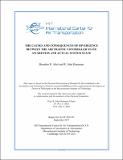| dc.contributor.author | Abel, Brandon | |
| dc.contributor.author | Hansman, R. John | |
| dc.date.accessioned | 2017-10-18T18:18:48Z | |
| dc.date.available | 2017-10-18T18:18:48Z | |
| dc.date.issued | 2017-10-18 | |
| dc.identifier.uri | http://hdl.handle.net/1721.1/111948 | |
| dc.description.abstract | Divergence is an inconsistency between the human’s system state awareness and the actual system state. This research investigated divergence potential in air traffic controllers and identified controller divergence causes and consequences. Based on this investigation, approaches to minimize controller divergence and its consequences were identified for current air traffic control systems and future systems where unmanned aircraft will be integrated.
Prior studies identified pilot divergence as a factor in several recent aircraft accidents and could be a factor for controllers. The future addition of unmanned aircraft in national airspace is a significant change which will affect the pilot and controller relationship and presents an opportunity to consider divergence before procedures are developed.
To understand how to minimize divergence and its consequences, this research developed a divergence cause and consequence framework and a cognitive process framework. The cause and consequence framework was developed using established risk analysis methods. The cognitive process framework was developed using established cognitive process and human error approaches. This research refined these frameworks and demonstrated their utility in an investigation of historical air traffic control accidents. They were then used to identify divergence vulnerabilities in a future unmanned aircraft-integrated national airspace.
Air traffic control cases were analyzed between 2011 and 2015 using the framework to understand causes and consequences of controller divergence. Twenty-seven (sixty-four percent) of these cases contained controller divergence contributing to the hazardous consequence. Although divergence causes and states varied, the most common event sequence included a diverged controller inducing an aircraft-to-aircraft conflict. These cases provided insight for system mitigations to reduce divergence causes and the consequentiality should it occur.
The potential emergence of controller divergence with the integration of unmanned aircraft in national airspace was then investigated. Field studies of controllers experienced managing unmanned aircraft identified important differences between manned and unmanned aircraft. The framework was then used to analyze these potential divergence vulnerabilities. Observables, specifically intent, appear more challenging to perceive yet crucial for controller projection of unmanned aircraft position due to their lack of onboard human perception, lost link, and automated operations. Hazardous consequences may be more likely due to the inability for unmanned aircraft to provide mitigations. | en_US |
| dc.description.sponsorship | This material is based upon work supported under Air Force Contract No. FA8721-05-C-0002 and/or FA8702-15-D-0001. | en_US |
| dc.language.iso | en_US | en_US |
| dc.relation.ispartofseries | ICAT;2017-07 | |
| dc.subject | Air Transportation | en_US |
| dc.subject | Divergence | en_US |
| dc.subject | air traffic controllers | en_US |
| dc.title | The Causes and Consequences of Divergence Between the Air Traffic Controller State Awareness and Actual System State | en_US |
| dc.type | Technical Report | en_US |
